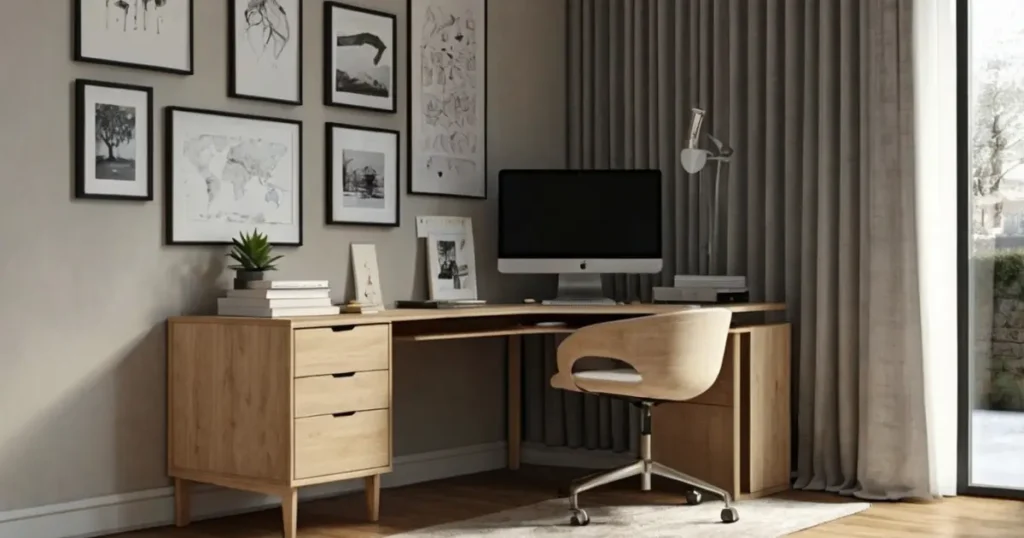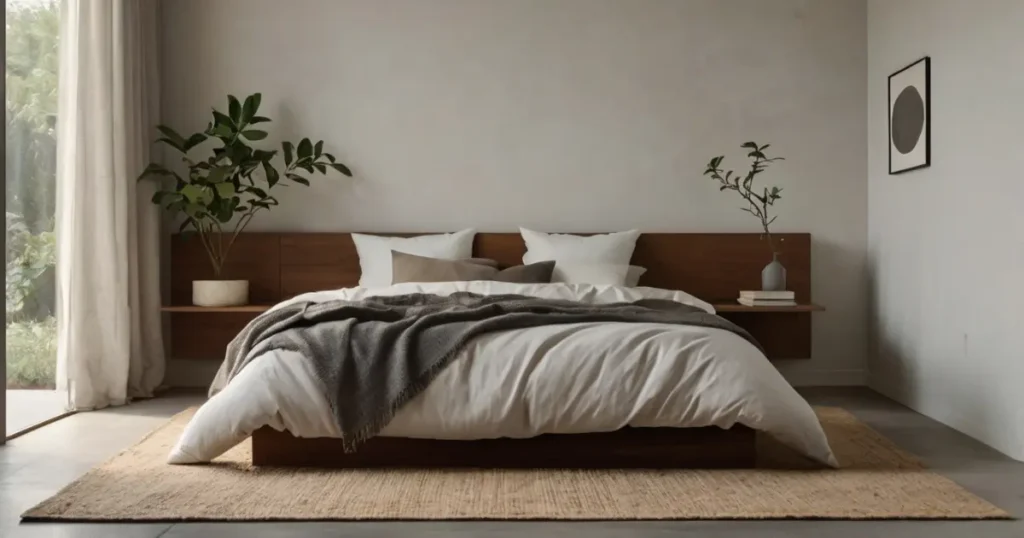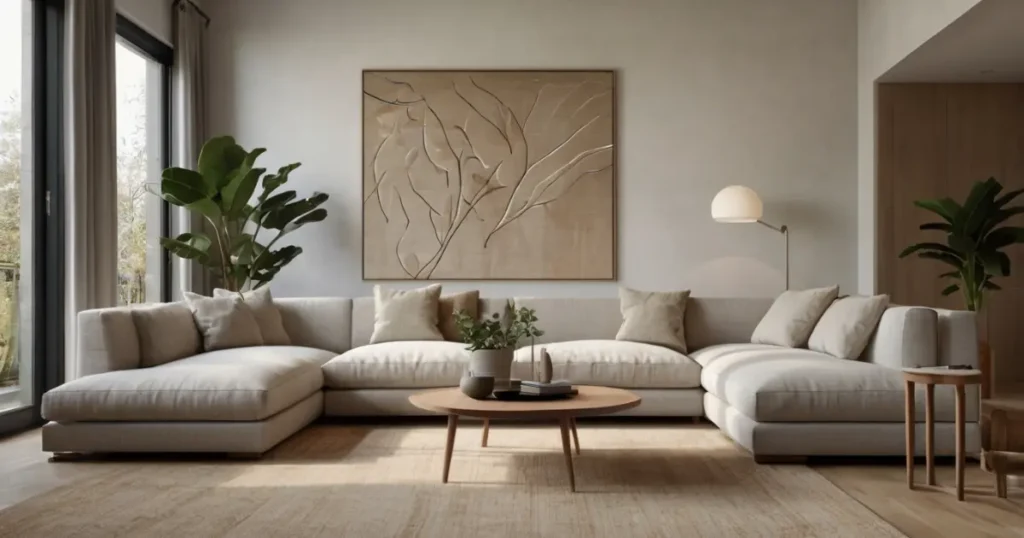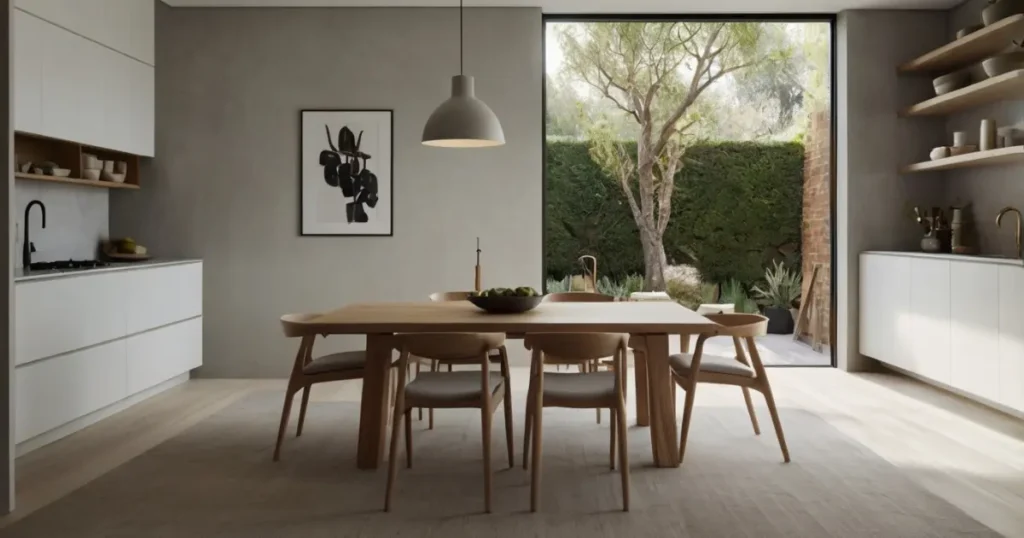I still remember the moment I walked into my friend Sarah’s apartment three years ago. The clutter that once dominated every surface had vanished, replaced by clean lines, purposeful furniture, and an overwhelming sense of peace. “How did you do this?” I asked, genuinely amazed by the transformation. Her answer changed everything: “I didn’t add more—I took away what didn’t serve me.” That conversation sparked my own journey into minimalist home décor, and I’ve never looked back.
The beauty of minimalist design isn’t about living with less for the sake of deprivation. It’s about creating intentional spaces that breathe, function beautifully, and support your well-being. According to research published in the Journal of Environmental Psychology, cluttered environments can significantly increase cortisol levels, our body’s primary stress hormone. When we embrace minimalist principles, we’re not just decorating—we’re actively creating sanctuaries that nurture our mental health.

Understanding the Foundation of Minimalist Style Home Design
Before diving into specific tips, let’s establish what makes a minimalist home truly effective. The philosophy centers on three core principles: functionality, intentionality, and visual harmony. Each element in your space should either serve a purpose, bring you joy, or ideally, both.
I learned this lesson the hard way when I first attempted minimalism. I removed everything from my living room, leaving only a couch and a coffee table. The space felt cold and unwelcoming—more like a waiting room than a home. True minimalism isn’t about emptiness; it’s about thoughtful curation.
The Scandinavian design movement, which heavily influences modern minimalist aesthetics, emphasizes the concept of “lagom”—a Swedish word meaning “just the right amount.” This philosophy perfectly captures what we’re aiming for: not too much, not too little, but exactly what feels right for your lifestyle and space.
My 10 Favorite Minimalist Home Décor Strategies That Actually Work
Over the past few years of experimenting with minimalist home décor, I’ve discovered that some techniques work beautifully while others fall flat in real life. The strategies I’m about to share aren’t just pretty ideas I found online—they’re the ones that have genuinely made my daily life easier, my space more functional, and my home a place I actually want to spend time in. I’ve arranged them in the order I’d recommend implementing them, starting with the foundation that makes everything else possible.
# 1 – Master the Art of Strategic Decluttering
The foundation of any minimalist home décor living room starts with intentional decluttering. I’ve discovered that the most effective approach isn’t the dramatic “throw everything away” method popularized by some organizing experts, but rather a thoughtful, room-by-room evaluation.
Start by removing everything from one area—let’s say your coffee table. Look at each item individually and ask: “Does this serve a function I use regularly, or does it genuinely make me happy when I see it?” Be honest with yourself. That decorative bowl you bought two years ago but never use? It’s time to let it go.
Research from UCLA’s Center on Everyday Lives of Families found that people living in cluttered homes showed higher levels of cortisol throughout the day compared to those in tidy environments. The physical act of decluttering isn’t just about aesthetics—it’s about creating a space that supports your mental well-being.
When I applied this principle to my own minimalist living room, I was surprised by how much I’d been holding onto out of guilt or “just in case” scenarios. The breathing room that emerged after thoughtful decluttering made the space feel twice as large and infinitely more peaceful.
# 2 – Choose Quality Over Quantity in Furniture Selection
One of the most transformative minimalist home décor ideas I’ve implemented is investing in fewer, higher-quality pieces. Instead of filling your space with multiple small furniture items, select substantial pieces that make a statement while serving multiple functions.
In my experience, a well-crafted wooden dining table that doubles as a workspace proves far more valuable than separate desks, side tables, and dining furniture. The key is choosing pieces with clean lines and neutral colors that won’t compete for attention or quickly go out of style.
The Herman Miller research has documented how quality furniture not only lasts longer but also maintains its aesthetic appeal across decades. When you’re building a minimalist house interior, think of each furniture piece as a long-term investment rather than a temporary solution.
I once spent months searching for the perfect sofa—visiting showrooms, reading reviews, and testing comfort levels. That careful selection process resulted in a piece I’ve loved for five years and counting, versus the multiple couches I’d previously replaced every 18 months due to poor quality or changing tastes.
# 3 – Embrace the Power of Negative Space
Negative space—the empty areas around and between objects—is perhaps the most overlooked element in modern minimalist home décor. I used to feel compelled to fill every corner, every wall, every surface. Learning to appreciate emptiness revolutionized how I approach interior design.
The Japanese concept of “ma,” which refers to the pregnant pause or meaningful emptiness in art and architecture, teaches us that what we don’t include is often as important as what we do. In practical terms, this means leaving walls bare, keeping surfaces clear, and allowing furniture to breathe within the room.
When I redesigned my bedroom using these principles, I removed the side tables, excess pillows, and decorative items that had accumulated over time. The result wasn’t sparse—it was serene. The few remaining elements, including a simple wooden bed frame and a single piece of artwork, became more impactful because they had space to shine.
Studies in environmental psychology show that rooms with adequate negative space promote better focus and reduce feelings of anxiety. Your minimalist home décor bedroom should feel like a retreat, not a storage unit.
# 4 – Develop a Cohesive Color Palette Strategy
Creating a harmonious minimalist home décor style requires disciplined color choices. I’ve found that limiting yourself to three main colors throughout your space creates visual continuity and prevents the chaotic feeling that comes from too many competing hues.
My personal palette consists of warm white, soft gray, and natural wood tones. This combination works in every room while allowing for subtle variations—perhaps a slightly cooler gray in the bathroom or a warmer white in the kitchen. The consistency creates flow and makes your home feel larger and more intentional.
Color psychology research from the University of Texas indicates that neutral color schemes can reduce visual fatigue and promote feelings of calm. When selecting your palette, consider how different colors make you feel. Cool blues and greens tend to be calming, while warm whites and beiges create coziness without overwhelming the senses.
The key is choosing colors you genuinely love rather than following trends. I’ve seen too many homes decorated in the popular “greige” (gray-beige) combination simply because it’s trendy, not because it resonates with the homeowner’s personal aesthetic.

# 5 – Incorporate Natural Elements and Textures
One criticism of minimalist design is that it can feel cold or sterile. The solution isn’t to add more objects—it’s to introduce natural elements and varied textures that create warmth and visual interest. This approach aligns perfectly with cozy minimalist home décor principles.
I’ve discovered that a single, well-placed plant can transform an entire room’s energy. The fiddle leaf fig in my living room corner serves as both a natural air purifier and a striking architectural element. Research from NASA’s Clean Air Study demonstrates that certain houseplants can remove up to 87% of air toxins within 24 hours.
Beyond plants, consider incorporating natural textures through materials like linen throw pillows, wool rugs, or wooden bowls. These elements add depth and warmth without cluttering the space. The tactile variety keeps minimalist spaces from feeling monotonous while maintaining the clean aesthetic.
I particularly love using different wood grains throughout my space—a smooth walnut coffee table paired with rougher reclaimed wood shelving creates visual interest while staying within the natural material family.
# 6 – Perfect Your Lighting Design Strategy
Lighting might be the most underestimated aspect of minimalist home décor trends. The right lighting can make a sparse room feel warm and inviting, while poor lighting can make even the most thoughtfully decorated space feel harsh or uninspiring.
I’ve learned to layer different types of lighting rather than relying on overhead fixtures alone. A combination of ambient lighting (general room illumination), task lighting (for specific activities), and accent lighting (to highlight particular features) creates depth and functionality.
The Lighting Research Center at Rensselaer Polytechnic Institute has found that varied lighting sources can improve mood, productivity, and sleep quality. In my minimalist living room, I use a combination of floor lamps, table lamps, and candles to create different moods throughout the day.
Natural light remains the gold standard for minimalist spaces. I’ve removed heavy curtains in favor of light-filtering blinds that maintain privacy while maximizing daylight. When natural light is limited, full-spectrum LED bulbs can provide similar benefits for both plant health and human well-being.
# 7 – Curate Meaningful Art and Decorative Objects
The art and decorative objects you choose for your minimalist home décor inspiration should tell your story while maintaining the clean aesthetic. I follow the “one wall, one piece” rule in most rooms, allowing each artwork to command attention without competing with neighbors.
Instead of multiple small pictures, I invest in larger pieces that can anchor a room. A single oversized photograph or painting creates more impact than a gallery wall of smaller items. This approach also makes the selection process more meaningful—each piece must truly resonate with you to earn its place.
When selecting decorative objects, I apply the “museum test”: would this item be interesting enough to display in a curated exhibition? This standard helps eliminate impulse purchases and ensures that every object adds genuine value to the space.
The key is choosing pieces that spark conversation or evoke emotional responses. My living room features a single ceramic vase made by a local artist—it’s beautiful, functional, and connects me to my community in a way that mass-produced decorations never could.

# 8 – Optimize Storage Solutions for Hidden Organization
Effective storage is crucial for maintaining modern minimalist home décor ideas. The goal is to have everything you need while keeping surfaces clear and uncluttered. I’ve found that investing in quality storage solutions pays dividends in both functionality and aesthetics.
Built-in storage, when possible, provides the cleanest look. However, most of us work with existing spaces that require creative solutions. I use furniture with hidden storage—ottomans with interior compartments, beds with drawers underneath, and coffee tables with shelving.
The Container Store’s organizational research shows that people with organized homes report higher life satisfaction and lower stress levels. The key is creating designated homes for everything you own, making it easy to maintain the minimalist aesthetic long-term.
I particularly love using baskets and boxes in natural materials like wicker or linen. These containers provide necessary storage while adding texture and warmth to the space. The uniformity of having matching storage solutions throughout the home creates visual cohesion.
# 9 – Create Functional Zones Within Open Spaces
Modern homes often feature open floor plans that can feel overwhelming without proper zoning. Creating distinct areas within larger spaces helps maintain the minimalist interior design for small house principles while ensuring functionality.
I use furniture placement and area rugs to define different zones. In my open living area, the sofa placement creates a conversation area, while a strategically placed bookshelf provides separation between the living space and home office area. This approach maintains flow while creating purpose-driven spaces.
Research from the Cornell University College of Human Ecology indicates that well-defined spaces within homes improve both productivity and relaxation. People need visual cues to understand how to use different areas, even in minimalist environments.
The trick is creating separation without building walls. Large plants, furniture orientation, and even ceiling-mounted curtains can provide definition while maintaining the open, airy feeling that makes minimalist spaces so appealing.
# 10 – Maintain Your Minimalist Space Through Daily Habits
The final and perhaps most crucial aspect of best minimalist home décor ideas is developing systems that maintain your carefully curated space. I’ve learned that minimalism isn’t a destination—it’s an ongoing practice.
I follow a “one in, one out” policy for most items. When I bring something new into my home, something else must leave. This prevents the gradual accumulation that can undermine minimalist principles over time.
Daily habits make the biggest difference. I spend 10 minutes each evening doing a quick reset—putting items back in their designated places, wiping down surfaces, and preparing the space for the next day. This small investment prevents the need for overwhelming weekend cleaning sessions.
The University of Minnesota’s research on environmental psychology shows that people who maintain organized spaces report better sleep quality and higher productivity levels. The effort invested in maintaining your minimalist space pays dividends in improved well-being.

The Deeper Impact of Minimalist Living
What started as a desire for a cleaner home has evolved into a philosophy that influences every aspect of my life. Minimalist home décor isn’t just about aesthetics—it’s about creating space for what truly matters.
The reduced visual clutter has improved my ability to focus on work, conversations, and creative projects. The simplified cleaning routines free up time for activities I enjoy more than housework. The intentional purchasing decisions have improved my financial health and reduced environmental impact.
Dr. Sherrie Bourg Carter, a psychologist specializing in stress management, notes in her research that physical clutter competes for attention and decreases performance. By creating minimalist spaces, we’re not just improving our homes—we’re optimizing our mental environment for success and well-being.
Your Journey Toward Intentional Living
Remember that minimalism isn’t about achieving perfection or comparing your space to carefully curated social media posts. It’s about creating an environment that supports your specific lifestyle and values. What works in my urban apartment might not suit your suburban home, and that’s perfectly fine.
Start small—perhaps with a single room or even just a coffee table. Notice how the changes make you feel. Do you experience less stress when you walk into the space? Are you more productive? Do you feel more peaceful? Let these observations guide your continued journey.
The most successful minimalist transformations happen gradually, with thoughtful consideration of each change. Rush the process, and you might end up with a space that feels stark rather than serene. Take time to live with changes before making additional modifications.
Conclusion: Creating Your Personal Sanctuary
As I write this, I’m sitting in my minimalist living room, surrounded by exactly what I need and nothing I don’t. The morning light filters through simple blinds, illuminating the few carefully chosen objects that make this space uniquely mine. The peace I feel isn’t accidental—it’s the result of intentional choices made over time.
Your journey toward minimalist home décor will be uniquely yours. The principles remain consistent—intentionality, quality over quantity, and respect for negative space—but the application will reflect your personal style, needs, and constraints. The goal isn’t to replicate someone else’s aesthetic but to create a space that serves your life beautifully.
Remember that every item you choose to keep or remove is a vote for the kind of life you want to live. Choose wisely, change gradually, and trust that the process of creating a minimalist home will teach you as much about yourself as it does about design.
The space you create will, in turn, shape who you become. Make it count.
Also read – The Art of One-Room Living: Transform Your Space from Cramped to Clever

Frequently Asked Questions (FAQs)
Q.1 – Is minimalism for the wealthy?
Not at all. Minimalism is actually more accessible to people with limited budgets because it focuses on buying fewer, higher-quality items rather than accumulating lots of stuff. You don’t need expensive designer pieces—minimalism works with thrift store finds, hand-me-downs, or whatever you already own. The key is choosing items intentionally, regardless of their price tag.
Q.2 – Why do millennials like minimalism?
Millennials embrace minimalism for several practical reasons. Many face student debt and high housing costs, making minimalism financially appealing. They also tend to move frequently for work, so owning less makes relocations easier. Additionally, growing up during the 2008 recession taught many millennials to question consumer culture, while social media exposure to minimalist aesthetics made the lifestyle visually appealing and accessible.
Q.3 – Is minimalism still trendy?
While minimalism peaked as a mainstream trend around 2016-2018, it has evolved into a lasting lifestyle choice rather than just a passing fad. The core principles—intentional living, reduced consumption, and mental clarity—address ongoing concerns about sustainability, mental health, and financial wellness. Though the extreme “Marie Kondo” moment has passed, minimalist principles continue influencing design, lifestyle, and consumer habits.
Q.4 – Where do I start as a minimalist?
Begin with one small area, like your bedside table or bathroom counter. Remove everything, clean the space, then only put back items you use regularly. This gives you a quick win and helps you understand how minimalism feels. Next, tackle one category of items (like books or clothes) rather than trying to declutter entire rooms. The key is starting small and building momentum gradually.
Q.5 – What is the 90 day rule in minimalism?
The 90-day rule asks two simple questions: Have you used that item in the last 90 days? If you haven’t, will you use it in the next 90? If the answer to both questions is no, then it’s okay to it let go. This approach helps you make practical decisions about your belongings based on actual usage patterns rather than hypothetical “what if” scenarios that often keep us holding onto clutter.
I believe the best insights come from real experiences, not just theory. What’s your take on minimalist home décor? Have you discovered any game-changing tips that I didn’t mention? Share your perspective in the comments—your unique approach might be exactly what another reader needs to hear.
Disclaimer: The information in this article is based on a combination of personal experience, design research, and insights from environmental psychology studies. While the decorating principles discussed are widely applicable, individual results may vary based on personal preferences, lifestyle needs, and specific living situations. When implementing significant changes to your living space, consider consulting with professional interior designers or organizers who can provide personalized guidance for your unique circumstances.
*Images used in this blog post article are for illustrative purposes only. We do not possess any copyrights to these images unless explicitly mentioned.

Nikhil Shukla
About The Author
Nikhil, with a background in Technology, is deeply passionate about Interior Design and Home Décor. At Cherry Hills Home Living, he channels this passion into creating inviting and stylish living spaces. With a unique blend of analytical thinking and creative flair, Nikhil offers innovative ideas, practical tips, and inspiring guidance to help others transform their homes into cozy retreats.
An impressive share, I just given this onto a colleague who was doing a little analysis on this. And he in fact bought me breakfast because I found it for him.. smile. So let me reword that: Thnx for the treat! But yeah Thnkx for spending the time to discuss this, I feel strongly about it and love reading more on this topic. If possible, as you become expertise, would you mind updating your blog with more details? It is highly helpful for me. Big thumb up for this blog post!
Thank you!
Sure, will update more details on this later.